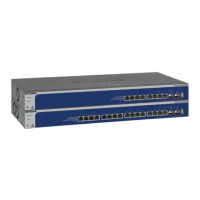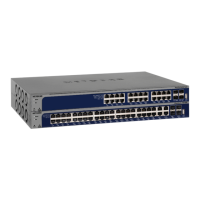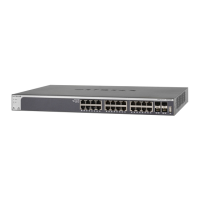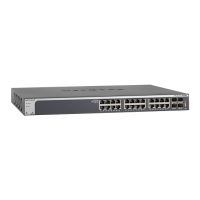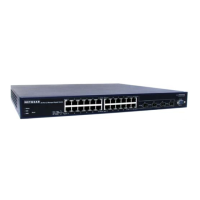Configure System Information
41
XS708T, XS712Tv2, and XS716T Smart Managed Pro Switch User Manual
The updated configuration is sent to the switch. Configuration changes take effect
immediately.
IPv6 Network Configuration
Use the IPv6 Network Configuration page to configure the IPv6 network interface, which is
the logical interface used for in-band connectivity with the switch through all of the switch’s
front-panel ports. The configuration parameters associated with the switch’s network
interface do not affect the configuration of the front panel ports through which traffic is
switched or routed.
To access the switch over an IPv6 network, you must initially configure the switch with IPv6
information (IPv6 prefix, prefix length, and default gateway). IPv6 can be configured using
any of the following options:
• IPv6 auto-configuration
• DHCPv6
When in-band connectivity is established, IPv6 information can be changed using
SNMP-based management or web-based management.
To configure the network information for an IPv6 network:
1. Connect your computer to the same network as the switch.
You can use a WiFi or wired connection to connect your computer to the network, or
connect directly to a switch that is off-network using an Ethernet cable.
2. Launch a web browser.
3. In the address field of your web browser, enter the IP address of the switch.
If you do not know the IP address of the switch, see Change the Default IP Address of the
Switch on page 10.
The login window opens.
4. Enter the switch’s password in the Password field.
The default password is password.
The System Information page displays.
5. Select System > Management > IPv6 Network Configuration.
The IPv6 Network Global Configuration page displays.
6. Next to Admin Mode, ensure that the Enable radio button is selected.
7. Determine how the switch acquires an IPv6 address:
• IPv6 Address Auto Configuration Mode. When this mode is enabled, the network
interface can acquire an IPv6 address through IPv6 Neighbor Discovery Protocol
(NDP) and through the use of router advertisement messages. When this mode is
disabled, the network interface does not use the native IPv6 address
auto-configuration features to acquire an IPv6 address. Auto-configuration can be
enabled only when DHCPv6 is not enabled on any of the management interfaces.
